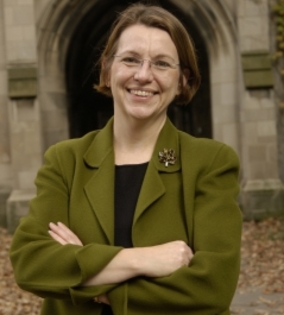Glorious, Vulnerable Life: A Q&A With Dr. Kristine A. Culp
January 26, 2016 • By Kristine A. Culp
The concept of vulnerability is central to any discussion of the enhancement or the endangerment of life. But many times, vulnerability is seen either as merely negative, or the counterpoint to resilience. Neither of these interpretations is capacious enough to capture our lived existence, according to Kris Culp, Associate Professor of Theology at the University of Chicago Divinity School and Dean of the Disciples Divinity House. Instead, she is exploring the possibilities of glory as a resource for understanding the enhancement and endangerment of life. By signaling transformation while also keeping perishability and danger in view, she argues that glory can help expand the narrative field for interpreting vulnerable life.
Read a blog post by Kristine Culp about an exhibition that explores the glories of mundane things here.
What was the spark for the research you’re pursuing for the Enhancing Life Project? Are these new questions, or an extension of past research, or both?
I have been thinking about vulnerability for a while and wrote a book on vulnerability and glory. But glory was in the background there, so I wanted to shift and look at glory as a resource for thinking about the enhancement and endangerment of life. It’s an interesting term because it’s quasi-theological, but glory is also part of popular parlance: “such-and-such in all its glory.” In the Sermon on the Mount, Jesus says: “Consider the lilies of the field…. Even Solomon in all his wonder was not clothed like one of these.” That’s clearly located in a theological context. But even there, glory functions first to compare lilies and King Solomon. Or, see John Muir on the Sierra; he writes about glorious days, glorious nights, glorious trees, glorious mountains… Glory is a quasi-theological term for Muir, as well. It’s partly aesthetic, it’s partly sensory, and it suggests this saturation or full aliveness. Even in ambiguous uses, glory stretches boundaries.
What are some of the reference points you’ve used to understand glory?
I’m working with a range of historical-theological and interdisciplinary materials, but in thinking through them, I keep coming back to two points of comparison. One is the glory of the lilies, and the other is the experience of paintings from Mark Rothko’s classic period. I don’t think you can stipulate a definition of glory and be done with it, because it’s partly a perceptual, phenomenological category. Glory has to be pointed to, perceived, understood. Rothko’s paintings can offer a common point of reference for persons from diverse disciplines to talk about what they perceive and experience. In his classic paintings, fields of color float on top of each other, intersect, and they recede and advance toward the viewer, pulling you in. The paintings pulse, in a way. I see that as both an experience and an analogy of full aliveness.
With the lilies, why is their glory exemplary? One reading would be that it’s natural rather than human-made or acquired. But the other interesting thing is that their glory is evanescent. It lasts but a day. Their vulnerability and perishability doesn’t make them any less glorious, but perhaps more so; glory doesn’t overwhelm their perishability. It’s there in the midst of it. Often we have this sense that glory involves permanence—think about King Solomon, who was storied to be powerful, wise, pious, and so wealthy that his temple is built with gold hinge sockets. Both Rothko’s paintings and the lilies suggest that glory isn’t necessarily about being more, having more, or becoming something else. It may even be heightened at the moment that perishability and vulnerability are also most evident.
You mentioned that there has been a historical debate around the concept of glory. How did that manifest?
I’m interested in the practical-theological debates that turn on the relation among the glory of God and the glory of creation and created things. Many of these debates took place, historically, with reference to the arts: architecture, visual arts, and music. The concern was whether human-made things can magnify the glory of God, whether they have their own intrinsic glory, or whether any glory attributed to made things is improperly taken away from God. For example, Cistercians were very suspicious of elaborate and fanciful architectural decoration; they questioned whether it invited a kind of improper curiosity that led away from God. A few centuries later, the Council of Trent rejected polyphonic music in favor of uplifting harmonies and intelligible words in the sung mass—so worshipers weren’t caught up in the music itself, but are able to understand that the music refers back to the glory of God.
These debates may seem somewhat removed from our lives, but I think similar concerns remain in the questions we ask today. Last week, Nicole Vincent was looking at whether hyper-alertness is better, or whether it’s in some way directing a person away from her own full aliveness. We need ways of engaging the world that help us think and feel our way through such complex endangerments and possibilities of enhancement. There are theological resources that can help cultivate felt sensibilities and critical thinking.
You don’t spend all of your time doing research and teaching! What’s your favorite place to travel, or the next place you’d like to go?
I like to travel, and in traveling I’m always torn between re-visiting the places that haunt me in good ways and the awareness of not wanting to circumscribe travels and places. One of the best things about traveling is planning and anticipating it. I just learned that I'll be going to the Philippines in the fall, for a consultation on globalization convened by the World Council of Churches. I feel very privileged to participate.